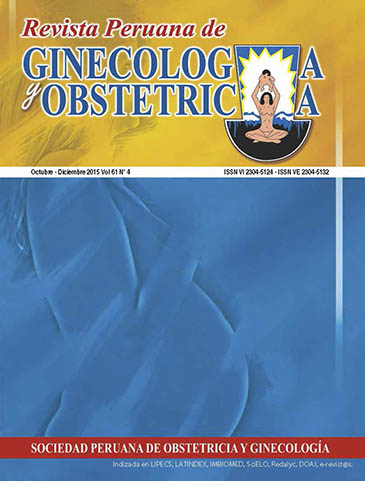Pelvic reconstructive surgery for severe genital prolapse using anterior prosthesis with sacrospinous ligament fixation
DOI:
https://doi.org/10.31403/rpgo.v61i1867Abstract
Changes in the population pyramid result in more adult female population consulting for pelvic floor dysfunction. Objective: To evaluate results of severe genital prolapse reconstructive pelvic surgery by anterior prosthesis with sacrospinous ligament fixation. Design: Retrospective and descriptive study. Setting: Specialized Gynecology Service, Hospital Nacional Edgardo Rebagliati Martins, EsSalud, Lima, Peru. Participants: Women with diagnosis of total genital prolapse. Method: A retrospective study of 12 patients admitted for genital prolapse and desire to retain vaginal function and having reconstructive pelvic surgery with mesh fixed to the sacrospinous ligament. Main outcome measures: Results of techniques used. Results: Average age was 64 years (range 56–75). Main comorbidity was obesity (body mass index 29.1). Patient’s main complaint was a feeling of lump in genitalia in 91%, and most had had abdominal hysterectomy. Vaginal hysterectomy plus anterior mesh (Perigee) with sacrospinous fixation was performed in 3 patients, only anterior mesh with sacrospinous fixation in 4 patients, anterior mesh with sacrospinous fixation and trans-obturator tape (Monarc) –TOT- in 3 patients, vaginal hysterectomy with anterior mesh (Perigee), sacrospinous fixation and trans-obturator tape (Monarc) in two patients. Complications included mesh extrusion in one patient, two patients without TOT had stress urinary incontinence, one presented urinary urgency, one dyspareunia, two patients had granuloma in the suture area, and one referred nonspecific pelvic pain; symptoms were not present in subsequent visits, and vaginal prolapse was not over grade I. Conclusions: The use of TOT and anterior mesh resulted in cure of urinary stress incontinence and no recurrence of defects when the apical anterior compartment was fixed to the sacrospinous ligament.Downloads
Download data is not yet available.
Downloads
Published
2016-01-16
How to Cite
Sandoval Diaz, I., Hernández Alarcón, R., Torres Arones, E., & Solano Choque, N. (2016). Pelvic reconstructive surgery for severe genital prolapse using anterior prosthesis with sacrospinous ligament fixation. The Peruvian Journal of Gynecology and Obstetrics, 61(4), 369–377. https://doi.org/10.31403/rpgo.v61i1867
Issue
Section
Artículos Originales
















